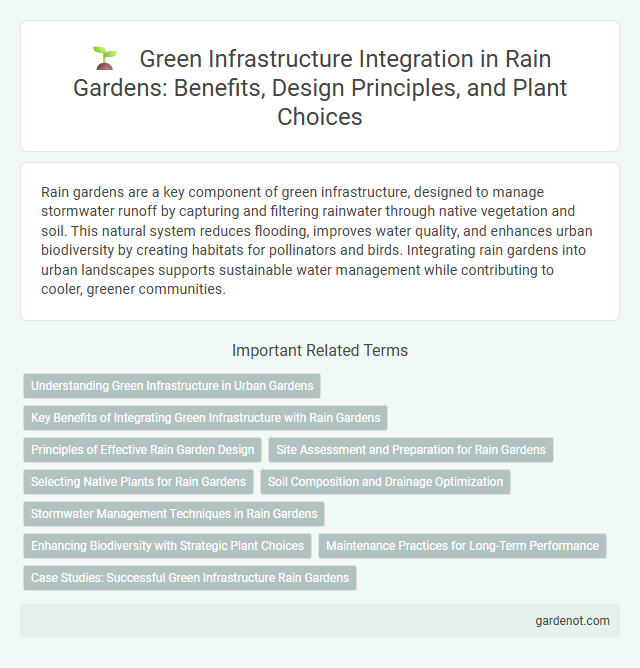Rain gardens are a key component of green infrastructure, designed to manage stormwater runoff by capturing and filtering rainwater through native vegetation and soil. This natural system reduces flooding, improves water quality, and enhances urban biodiversity by creating habitats for pollinators and birds. Integrating rain gardens into urban landscapes supports sustainable water management while contributing to cooler, greener communities.
Understanding Green Infrastructure in Urban Gardens
Green infrastructure in urban gardens integrates rain gardens as essential components for managing stormwater runoff and enhancing biodiversity. By utilizing native plants and permeable soil layers, rain gardens reduce urban flooding and improve water quality through natural filtration processes. These sustainable landscapes contribute to urban resilience by promoting groundwater recharge and decreasing reliance on traditional drainage systems.
Key Benefits of Integrating Green Infrastructure with Rain Gardens
Integrating green infrastructure with rain gardens enhances stormwater management by reducing runoff volume and improving water quality through natural filtration. This combination supports urban biodiversity by creating habitats for native plants and pollinators, promoting ecological resilience. It also mitigates urban heat island effects by increasing green space, which lowers local temperatures and improves air quality.
Principles of Effective Rain Garden Design
Effective rain garden design prioritizes soil permeability, native plant selection, and proper sizing to enhance stormwater infiltration and reduce runoff. Strategic placement near impervious surfaces maximizes water capture while preventing flooding and erosion. Incorporating mulch layers and overflow outlets ensures durability and environmental resilience within urban green infrastructure.
Site Assessment and Preparation for Rain Gardens
Site assessment for rain gardens involves evaluating soil permeability, slope, and drainage patterns to ensure optimal water infiltration and prevent flooding. Proper site preparation includes removing impermeable surfaces, amending soil with organic matter, and grading the area to direct runoff into the garden. Strategic placement within green infrastructure systems maximizes stormwater management and supports urban biodiversity.
Selecting Native Plants for Rain Gardens
Selecting native plants for rain gardens enhances green infrastructure by improving stormwater absorption and reducing runoff pollution. Native species are adapted to local soil and climate conditions, requiring less maintenance and supporting local biodiversity. Incorporating deep-rooted native plants like sedges, rushes, and wildflowers maximizes water filtration and soil stabilization in rain garden systems.
Soil Composition and Drainage Optimization
Rain gardens rely on engineered soil composition, typically a mix of sand, compost, and topsoil, to enhance infiltration and support plant growth while preventing waterlogging. Optimized drainage within rain gardens ensures efficient capture and slow release of stormwater, reducing runoff and promoting groundwater recharge. Proper selection and layering of soil materials maximize pollutant filtration and improve the garden's overall water management performance.
Stormwater Management Techniques in Rain Gardens
Rain gardens represent a key component of green infrastructure by effectively managing stormwater through natural filtration and infiltration processes. These gardens utilize native plants and engineered soil layers to capture, absorb, and slow runoff, thereby reducing pollution and minimizing urban flooding. Integrating rain gardens into stormwater management systems enhances groundwater recharge and improves water quality in urban environments.
Enhancing Biodiversity with Strategic Plant Choices
Strategic plant choices in rain gardens significantly enhance biodiversity by supporting native pollinators, birds, and beneficial insects. Selecting diverse native species with varied bloom times ensures continuous habitat and food sources throughout the growing season. Integrating deep-rooted plants improves soil structure and water infiltration, promoting a resilient green infrastructure system.
Maintenance Practices for Long-Term Performance
Regular maintenance of rain gardens, including sediment removal, pruning of vegetation, and inspection of inlet and outlet structures, ensures sustained stormwater infiltration and pollutant removal. Monitoring plant health and replacing dead or invasive species improves filtration efficiency and supports biodiversity in green infrastructure systems. Implementing seasonal maintenance schedules enhances long-term performance and resilience of rain gardens in urban stormwater management.
Case Studies: Successful Green Infrastructure Rain Gardens
Rain gardens effectively manage stormwater runoff by capturing and filtering rainwater, reducing urban flooding and improving water quality in cities like Seattle, Washington. Case studies from Portland, Oregon, demonstrate how strategically placed rain gardens increased groundwater recharge while enhancing urban biodiversity and community aesthetics. In Toronto, Canada, municipal rain garden projects have successfully decreased combined sewer overflows by up to 50%, showcasing their impact on sustainable green infrastructure development.
Green infrastructure Infographic

 gardenot.com
gardenot.com